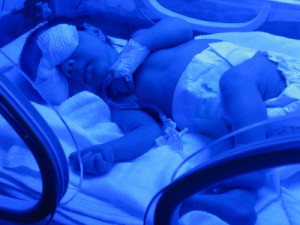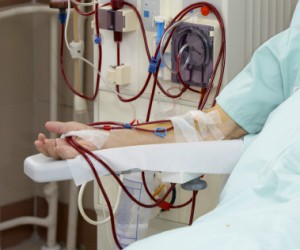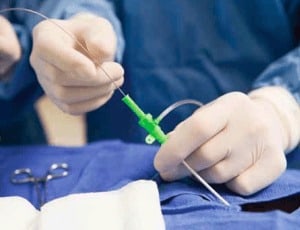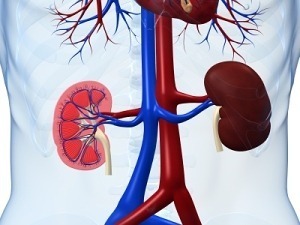Presepsin as a predictor of positive blood culture in suspected neonatal sepsis

The aim of this study was therefore to evaluate the accuracy of presepsin (P-SEP) as a novel biomarker of bacterial infection for neonatal sepsis diagnosis” Miyosawa et al (2018). Abstract: Background: Although the incidence of neonatal sepsis is decreasing, neonatal sepsis remains a severe life-threatening disease. No current biochemical marker can provide perfect diagnostic accuracy […]
Ten year outpatient parenteral antibiotic therapy review from Australia

This study reviewed the practice of an OPAT service in a large Australian tertiary teaching hospital in Western Sydney over a 10-year period” Li et al (2018). Abstract: PURPOSE: Outpatient parenteral antibiotic therapy (OPAT) is a widely accepted and safe therapeutic option for carefully selected patients. This study reviewed the practice of an OPAT service […]
Review of fifty years of long-term central venous access

Critical issues include catheter-related infections, venous injury, thrombosis, chronic inflammation, fibrosis, occlusion, and progressive attrition of central venous capital” Baskin et al (2018). Abstract: Fifty years ago, the first central venous access devices (CVADs) intended for long-term use were used to deliver parenteral nutrition (1). The index patient required 16 catheters in 5 different locations […]
What is the patient experience of health care–associated infection?

The impact of different HAIs may vary; however, there are many similarities in the experience recounted by patients” Currie et al (2018). Abstract: Background: The global burden of health care–associated infection (HAI) is well recognized; what is less well known is the impact HAI has on patients. To develop acceptable, effective interventions, greater understanding of […]
Vascular access variation in the haemodialysis access journey

The modality by which haemodialysis (HD) is delivered [arteriovenous fistula (AVF), arteriovenous graft (AVG) or central venous catheter (CVC)] varies widely and is influenced by clinical evidence, patient factors and the prevailing service configuration. The aim of this study was to determine the outcome and impact of access strategy on patient outcome by mapping out […]
Decreasing hospitalizations in patients on hemodialysis
Hospitalizations drive up to 35% of the astronomical costs of care for patients on hemodialysis and are associated with poor outcomes” Golestaneh (2018). Abstract: Hospitalizations drive up to 35% of the astronomical costs of care for patients on hemodialysis and are associated with poor outcomes. We describe outpatient care-sensitive categories of hospitalization risks in an […]
Fluid resuscitation in pre-hospital management of septic shock
The outcome of septic patients relies on the early identification and rapid implementation of appropriate treatments, including hemodynamic optimization and antibiotics administration” Jouffroy et al (2018). Abstract: The estimated incidence of sepsis is approximately 300 per 100,000 inhabitants [1,2], making sepsis a major public health problem, with a mortality rate reaching 30% at day 28 […]
Comparison of error rates between intravenous push methods

This study aims to compare the number of observed medication preparation and administration errors between the only commercially available ready-to-administer product (Simplist) and IV push traditional practice, including a cartridge-based syringe system (Carpuject) and vials and syringes” Hertig et al (2018). Abstract: Objectives: Current literature estimates the error rate associated with the preparation and administration […]
Impact of occupational splash, sharps and needlestick injuries

Infection as a consequence of splash sharps and needlestick injuries (SSNIs) is a hazard faced by healthcare workers” Ongete and Duffy (2018). Abstract: BACKGROUND: Infection as a consequence of splash sharps and needlestick injuries (SSNIs) is a hazard faced by healthcare workers. Little is known about the impact this has on quality of life particularly […]
Complications associated with outpatient central venous catheters

Medically attended catheter complications were common among outpatients discharged with a CVC, and reduction of these events should be the focus of outpatient quality improvement programs” Spires et al (2018). Abstract: OBJECTIVE: Outpatient central venous catheters (CVCs) are being used more frequently; however, data describing mechanical complications and central-line-associated bloodstream infections (CLABSI) in the outpatient […]
Safety of bolus-dose phenylephrine for hypotensive ED patients

Bolus-dose phenylephrine (BDPE) is routinely used to treat hypotension in the operating room. BDPE’s fast onset of action and ability to be administered peripherally have prompted calls for its use in the Emergency Department (ED)” Swenson et al (2018). Abstract: Introduction: Bolus-dose phenylephrine (BDPE) is routinely used to treat hypotension in the operating room. BDPE’s […]
Invasive fungal infections in patients with hematological malignancies

Treatment options for resistant fungal infections are limited and new drugs with novel mechanisms of actions are needed. Prevention of resistance through antifungal stewardship programs is of paramount importance” Gamaletsou et al (2018). Abstract: Invasive fungal infections caused by drug-resistant organisms, are an emerging threat to heavily immunosuppressed patients with haematological malignancies. Modern early antifungal […]
Impact of clinical interruptions on trainee performance during central venous catheterization

This experimental study compares the effects of interruptions on simulated performances of central venous catheterization during a highly versus minimally complex portion of the task” Jones et al (2017). Abstract: BACKGROUND: Interruptions are common in the healthcare setting. This experimental study compares the effects of interruptions on simulated performances of central venous catheterization during a […]
Vascular access choice for therapeutic plasma exchange

This article provides an overview of the characteristics of therapeutic plasma exchange, the clinical diseases and indications that may be treated with therapeutic plasma exchange, and the different types of vascular access employed, with their advantages and disadvantages” Ipe and Marques (2018). Abstract: Therapeutic plasma exchange is an apheresis modality in which plasma is separated […]
Which vascular access device for cellular collection by apheresis?

Here, different types of vascular access approaches used in cellular collections are discussed, and this information is supplemented by the author’s experience and practice in areas where published information is limited” Padmanabhan (2018). Abstract: Cellular collection is an important and increasingly used apheresis procedure. These collections are performed by leukocytapheresis, a procedure involving the removal […]
Extracorporeal photopheresis cell treatment explained

Extracorporeal photopheresis (ECP) has demonstrated efficacy as second-line treatment for steroid-refractory (SR) acute graft-versus-host disease (aGVHD). The aim of our study was to analyze whether the amount of ECP-treated cells in patients with SR, aGVHD has an impact on response at 1 month” Worel et al (2018). Abstract: BACKGROUND: Extracorporeal photopheresis (ECP) has demonstrated efficacy […]
Vascular access devices used in extracorporeal photopheresis
The primary objective of this study was to compare pressures at various flow rates for central venous access devices in an ex vivo simulation of photopheresis” Szymanski et al (2018). Abstract: BACKGROUND: Central venous access devices are commonly used in extracorporeal photopheresis, but their performance has not been systematically evaluated. The primary objective of this […]
How to reduce inappropriate peripheral IV cannulation in the ED?

The intervention focused on improving appropriate use of PIVCs in an emergency setting by emphasizing to clinicians that a PIVC should only be placed if it was believed there was more than an 80% chance that it would be used” Rangarajan et al (2018). Abstract: This is a prospective before-after study comparing peripheral intravenous cannulation […]
Fluid therapy and outcomes in 65 German intensive care units

We conducted this prospective, observational study to investigate current practice of fluid therapy (crystalloids and colloids) and associated outcomes in 65 German intensive care units (ICUs)” Ertmer et al (2018). Abstract: Background: Outcome data on fluid therapy in critically ill patients from randomised controlled trials may be different from data obtained by observational studies under […]
Implanted central catheter repositioning for treatment of malignant SVC obstruction

We report the case of a patient with SVC syndrome caused by tumoral obstruction due to central small-cell lung cancer who had right subclavian implanted CVC and a preferential head and neck venous drainage through the left internal jugular and brachiocephalic vein (BCV)” Volpi et al (2018). Abstract: Superior vena cava (SVC) syndrome is a […]
Exploring the nurses’ role in antibiotic stewardship

Nurses appeared to be enthusiastic about participating in antibiotic stewardship” Carter et al (2018). Abstract: Background: There is a growing recognition of the need to partner with nurses to promote effective antibiotic stewardship. In this study, we explored the attitudes of nurses and infection preventionists toward 5 nurse-driven antibiotic stewardship practices: 1) questioning the need […]
Vascular access choices for red blood cell exchange
In this review, we discuss the recognized indications for red blood cell exchange, considerations for the selection of exchange modality and vascular access, and recommendations for the appropriate care and prevention of risks associated with vascular access” Otrock et al (2018). Abstract: Red blood cell exchange is the process of removing red blood cells from […]
Biofilm as a prognostic tool in adults with candidemia?

We aimed to determine the impact of biofilm production measured by metabolic activity (MA) and biomass (BM) on the prognosis of adults with candidemia” Muñoz et al (2018). Abstract: Objectives: The role of biofilm production in the outcome of candidemia remains under discussion. Current evidence relies on variable biofilm detection methods while evaluating distinct clinical […]
Important developments in vascular access from the past year
There is renewed interest in vascular access research, fueled by new perspectives and a critical re-examination of traditional thinking. This review summarizes important developments in vascular access from the past year, highlight areas of controversy, and makes recommendations for future research” Papini et al (2018). Abstract: PURPOSE OF REVIEW: There is renewed interest in vascular […]
Significant CLABSI reduction in 11 Hospitals of 5 Cities in Argentina

Implementing IMA through ISOS was associated with a significant reduction in the CLABSI rate in ICUs in Argentina” Rosenthal et al (2018). Abstract: OBJECTIVE: To analyze the impact of the International Nosocomial Infection Control Consortium (INICC) Multidimensional Approach (IMA) and the INICC Surveillance Online System (ISOS) on central line-associated bloodstream infection (CLABSI) rates in 14 […]
Criteria to determine acute kidney injury in the critically ill patient

However, if renal failure becomes established, then renal replacement therapy (RRT) may be needed to maintain homoeostasis. While there are no clear guidelines with respect to the ideal mode or timing of RRT, we will discuss pros and cons of the various bedside options” Flood and Nichol (2018). Abstract: Acute renal failure is commonly encountered […]
Vascular access devices from an interventional radiology perspective
The purpose of this article is to familiarize the reader with the role of Interventional Radiology in the placement and management of intravascular or implantable access devices, with a focus on discussing indications for central venous catheter placement, implantation techniques, potential complications, and management of catheter dysfunction” Lee and Ramaswamy (2018). Abstract: Central venous access […]
Complications of implantable vascular access device ports

We review the evidence related to these advances and their effect on the safety profile and complications of implantable vascular access device ports” Blanco-Guzman (2018). Abstract: Implantable vascular access devices are frequently used in patients who have poor peripheral venous access. These devices can be partially implanted as tunneled and nontunneled central catheters, or they […]
Vascular access considerations for extracorporeal photopheresis
Photopheresis is a very safe procedure; however, the complications and impact on the patient’s quality of life associated with vascular access devices can be significant” Adamski (2018). Abstract: Extracorporeal photopheresis is an immunomodulatory therapy indicated for patients with cutaneous T-cell lymphoma, graft-versus-host disease, and heart or lung allograft rejection. Whole blood from the patient is […]
Time required to establish neonatal emergency vascular access

To compare the duration to establish an umbilical venous catheter and an intraosseous access in real hospital delivery rooms and as a secondary aim to assess delaying factors during establishment and to provide recommendations to accelerate vascular access in neonatal resuscitation” Schwindt et al (2018). Abstract: OBJECTIVES: To compare the duration to establish an umbilical […]

